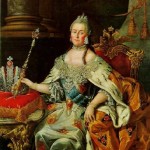 She was known as Catherine II during her reign over Russia from June 28th, 1762- November, 17th 1796. Catherine took power after a conspiracy deposed her husband, Peter III (1728–1762), and her reign saw the high point in the influence of the Russian nobility. Under her direct auspices the Russian Empire expanded, improved its administration, and continued to westernize. Catherine’s rule re-vitalized Russia, which grew ever stronger and became recognized as one of the great powers of Europe. During her reign Catherine extended the borders of the Russian Empire southward and westward to absorb New Russia, Crimea, Right-Bank Ukraine, Belarus, Lithuania, and Courland at the expense, mainly, of two powers – the Ottoman Empire and the Polish–Lithuanian Commonwealth. Her successes in complex foreign policy and her sometimes brutal reprisals in the wake of rebellion (most notably Pugachev’s Rebellion) complemented her hectic private life. She frequently occasioned scandal — given her propensity for relationships which often resulted in gossip flourishing within more than one European court. Catherine, throughout her long reign, took many lovers, often elevating them to high positions for as long as they held her interest, and then pensioning them off with large estates and gifts of serfs.
She was known as Catherine II during her reign over Russia from June 28th, 1762- November, 17th 1796. Catherine took power after a conspiracy deposed her husband, Peter III (1728–1762), and her reign saw the high point in the influence of the Russian nobility. Under her direct auspices the Russian Empire expanded, improved its administration, and continued to westernize. Catherine’s rule re-vitalized Russia, which grew ever stronger and became recognized as one of the great powers of Europe. During her reign Catherine extended the borders of the Russian Empire southward and westward to absorb New Russia, Crimea, Right-Bank Ukraine, Belarus, Lithuania, and Courland at the expense, mainly, of two powers – the Ottoman Empire and the Polish–Lithuanian Commonwealth. Her successes in complex foreign policy and her sometimes brutal reprisals in the wake of rebellion (most notably Pugachev’s Rebellion) complemented her hectic private life. She frequently occasioned scandal — given her propensity for relationships which often resulted in gossip flourishing within more than one European court. Catherine, throughout her long reign, took many lovers, often elevating them to high positions for as long as they held her interest, and then pensioning them off with large estates and gifts of serfs.
Questions for discussion in class:
Why did Catherine confer on the nobility the Charter to the Nobility, increasing further the power of the landed oligarchs?
Why do you think Catherine constantly created projects that would legitimate her status as the empress?
By Lindsay Rubio and JP Verheul
2 replies on “Catherine The Great?”
The Charter was essential to maintaining the aristocracy’s loyalty. Catherine, herself coming to power through a coup, knew all too well the dangers hostile nobility posed to her reign—and survival. By granting them many privileges, Catherine pacified their hostility. Moreover, the new generation of gentry owed its prosperity and titles to her, engendering a loyalty which would counterbalance any antagonism arising between herself and the old aristocracy. Finally, the liberal sentiment beginning to stir amongst the lower classes throughout Europe jeopardized not only the empress but the entire imperial state. If Russia were to weather the coming storm, the monarch and the aristocracies had to unite. Catherine issued the Charter of Nobility to ensure this necessary solidarity in the face of an increasingly restive population.
The Charter was essential to maintaining the aristocracy’s loyalty. Catherine, herself coming to power through a coup, knew all too well the dangers hostile nobility posed to her reign—and survival. By granting them many privileges, Catherine pacified their hostility. Moreover, the new generation of gentry owed its prosperity and titles to her, engendering a loyalty which would counterbalance any antagonism arising between herself and the old aristocracy. Finally, the liberal sentiment beginning to stir amongst the lower classes throughout Europe jeopardized not only the empress but the entire imperial state. If Russia were to weather the coming storm, the monarch and the aristocracies had to unite. Catherine issued the Charter of Nobility to ensure this necessary solidarity in the face of an increasingly restive population.
– Richard Jordan